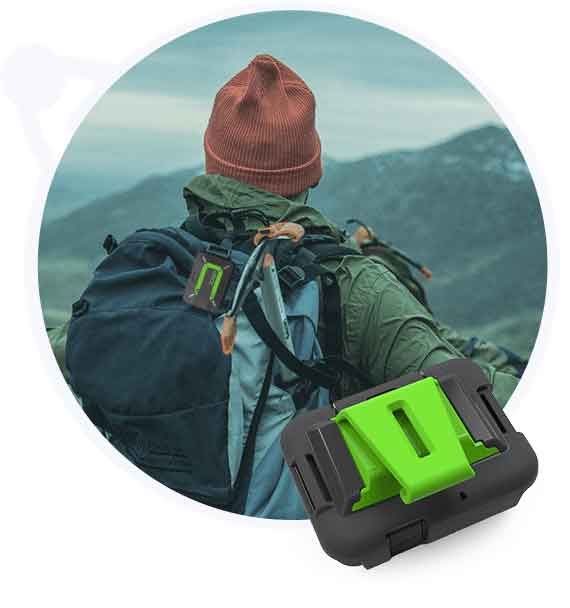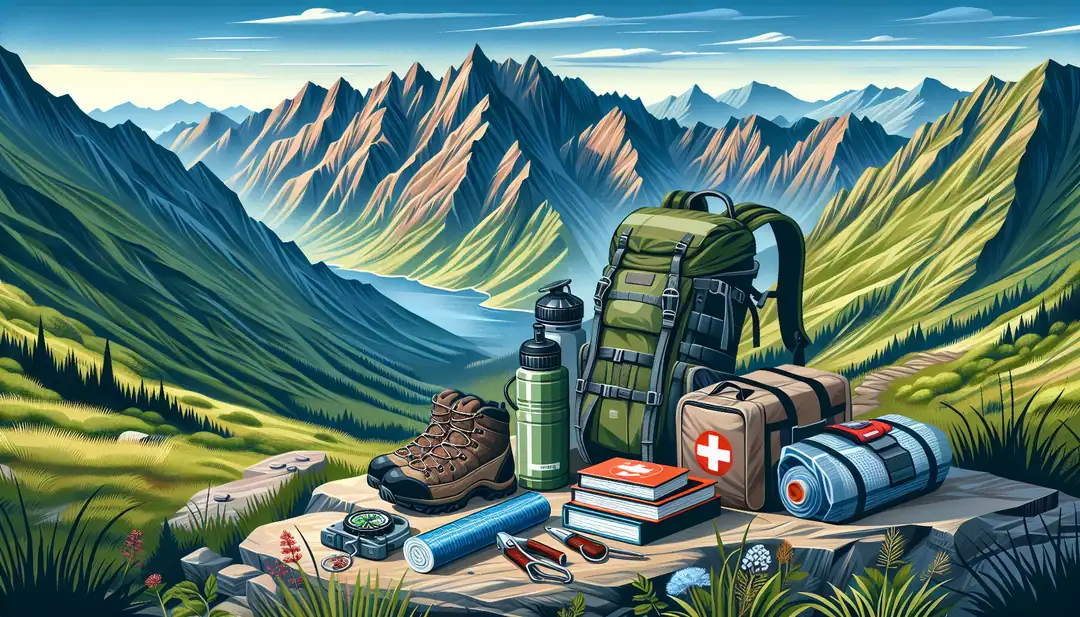Hiking offers an accessible way to explore nature, available as everything from short, leisurely trails to challenging, multi-day treks across various terrains. As you embark on day hiking, one of the most popular forms, it’s essential to address hiking safety to prevent injuries, especially given the recent spike in hiking-related accidents. Weather planning plays a critical role in ensuring a good experience; checking forecasts can help you avoid miserable conditions or accidents caused by poor weather.
To navigate the outdoors safely, integrating hiking safety measures like carrying a satellite communicator or personal locator beacon is crucial. This guide will cover essential tips for beginners, including selecting the right survival gear, employing night hiking safety strategies, and the importance of a solid safety plan. Whether it’s understanding the value of hiking sun protection, wilderness survival skills, or solo hiking safety, you’ll find the necessary steps to prepare for a secure outdoor adventure.
Understanding Hiking Risks
Understanding the risks you may face while hiking is crucial for ensuring your safety and preparedness. Here’s a closer look at common risks and tips for managing them:
- Medical Emergencies: Urgent situations like severe bleeding, snake bites, heart attacks, or strokes require immediate medical attention. Familiarize yourself with basic first aid treatments for these conditions to enhance safety on your hike.
- Common Injuries and Hazards:
- Sprains and Strains: Ensure your physical condition and footwear are suitable for rugged terrain, providing adequate cushioning and ankle support.
- Blisters and Sunburn: These can be prevented by wearing appropriate clothing and applying sunscreen regularly.
- Insect Bites and Heat-related Illnesses: Stay hydrated, and use insect repellent to avoid bites and stings.
- Terrain and Weather: Be aware of the terrain and weather conditions. Avoid hiking in extreme weather and always have a contingency plan.
- Water Shortages and Fatigue: Carry sufficient water and assess your physical condition regularly.
- Environmental Dangers:
- Avalanches and Rockfalls: Avoid snow-covered mountains during avalanche season and be cautious of falling rocks in areas prone to rockfalls.
- Floods and Flash Floods: Stay informed about the weather and avoid crossing fast-flowing rivers or streams.
- Wildlife Encounters: Be aware of the wildlife in the area you’re hiking and know how to react safely if you encounter dangerous animals.
By understanding these risks and preparing accordingly, you can significantly reduce the chances of encountering emergencies or injuries during your hiking adventures.
Preparing for Your Hike
Before embarking on your hiking adventure, proper preparation is essential to ensure a safe and enjoyable experience. Here’s a comprehensive guide to get you started:
Essential Pre-Hike Preparations:
- Arrival and Battery Check: Aim to arrive at your destination before dark to set up camp or start your hike with ample daylight. Begin your trip with a fully charged phone battery for emergencies.
- Hiking Companions: Whenever possible, bring a friend or two. They can assist with navigation, help in case of injuries, and provide company.
- Pace and Breaks: Move at a comfortable pace, enjoy the scenery, and take breaks as needed to prevent fatigue.
- Inform Someone: Always inform a trustworthy person about your hiking plans, including your intended route and estimated return time.
Gear and Clothing:
- Footwear: Invest in good hiking shoes and moisture-wicking socks to prevent blisters. Adjust your equipment based on weather, location, and hike duration.
- Hydration and Nutrition: Pre-hydrate before your hike, carry a hydration backpack, and bring snacks and high-energy foods. Know water sources along your route to plan refills.
- Sun Protection: Apply sunscreen (SPF 30 or higher), wear sunglasses, and a wide-brimmed hat. Reapply sunscreen every two hours.
- Clothing Layers: Dress in layers to easily adjust for changing weather. Wear moisture-wicking layers over cotton, and carry at least one extra layer of clothing.
Planning and Navigation:
- Route Research: Thoroughly research your route in advance. Check for potential animal life, poisonous plants, and local hiking alerts. Use maps, guidebooks, or a GPS file of the route.
- Weather and Conditions: Consult rangers for park conditions and research local weather patterns. Plan for an overnight, even on day hikes, to be prepared for unexpected situations.
- Leave No Trace: Know the regulations and special concerns for the area you’ll visit. Repackage food to minimize waste, and use a map and compass to avoid leaving marks.
Incorporating these preparations into your hiking routine can significantly enhance your safety and enjoyment. By planning ahead, preparing for various conditions, and bringing the right gear, you’re setting the stage for a successful outdoor adventure.
Essential Gear for Hiking Safety
To ensure your safety and preparedness on the trail, packing the right gear is essential. Here’s a comprehensive checklist of essential gear for hiking safety, categorized to help you organize your pack efficiently:
Navigation and Communication:
- Map and Compass/GPS: Always carry a paper map and compass as a reliable backup to electronic devices.
- GPS devices and navigation apps: Useful for supplementary navigation, but remember technology may not always be reliable.
- ZOLEO Satellite Communicator: A compact, reliable satellite communicator for emergency situations.
- Signalling device: Include a whistle and mirror for emergencies, alongside your mobile or satellite phone.

First Aid and Emergency Gear:
- First Aid Kit: Pack a kit suitable for the specific hike, including items like bandages, antiseptic wipes, pain relievers, and a space blanket. Consider taking a first aid class to be prepared.
- Firestarter: Carry a lighter, flint and striker, or waterproof matches for emergency warmth or signalling.
- Multi-tool and Pocket Knife: Essential for gear repair, first aid, and other unexpected needs.
- Emergency Shelter: Pack a lightweight space blanket or tarp for protection against the elements if stranded.
Personal Protection and Comfort:
- Sun Protection: Apply sunscreen, wear sunglasses, and dress in sun-protective clothing regardless of the season.
- Appropriate Footwear: Visit a local outdoor shop to get fitted for boots that match your unique fit and use case, and pair with merino wool, crew-length socks for comfort and blister prevention.
- Rain Gear & Dry-Fast Layers: Dress in moisture-wicking layers and carry rain gear to adjust to changing weather and activity levels.
- Water and Food: Carry a water bottle and enough calorie-dense foods, plus extra portions. Know where and how to treat water on the trail.
Remember, the key to hiking safety lies not only in carrying these essential items but also in knowing how to use them effectively. Adjust your gear list based on the duration, difficulty, and environmental conditions of your hike to ensure you’re well-prepared for a safe outdoor adventure.
The Importance of Hydration and Nutrition
Hydration and nutrition are pivotal for maintaining energy and ensuring safety during a hike. Here’s how to manage them effectively:
Hydration: The Lifeline of Hiking
- Water Intake: Carry and consume at least one litre of water for every two hours of hiking. The need for water can increase with the intensity of the hike, weather conditions, and individual health factors. Aim for0.5-1 liter of water per hour, adjusting as needed.
- Recognizing Dehydration: Symptoms include reduced endurance, impaired concentration, and an increased heart rate.Regularly monitor the color of your urine as a simple hydration check.
- Preventing Dehydration: Always bring enough water, and consider carrying a hydration backpack for easy access. In scenarios where you might sweat a lot, replenish lost water to maintain body temperature regulation and prevent overheating.
Nutrition: Fuelling Your Adventure
- Before the Hike: opt for a meal high in healthy carbs (whole-grain cereals, fruits, vegetables, brown rice) and moderate in protein and fat. This combination provides sustained energy, avoiding foods that are heavy in saturated fats and proteins which can make you feel sluggish.
- During the Hike: Consume high-energy, non-perishable snacks every 60-90 minutes. Recommended options include jerky, dried fruit, trail mix, or energy bars. These snacks are crucial for maintaining energy levels and should be high in carbohydrates and protein.
- After the Hike: Focus on replenishing glycogen stores and repairing muscles. Include a balanced mix of carbohydrates, protein, and healthy fats in your post-hike meal.
Electrolyte Balance: Key to Muscle and Energy
- Understanding Loss: Sweat contains essential electrolytes, whose loss can lead to muscle cramps and fatigue. Hikers can lose up to 4 litres of water per hour through sweating, which includes these vital electrolytes.
- Replenishment Strategies: While sports drinks can help replace lost electrolytes, they often contain high sugar levels. Consider low-sugar options or electrolyte supplements to avoid additional dehydration.
- Tailoring to Individual Needs: Keep in mind that hydration and nutrition needs vary by age, gender, fitness level, and medical history. Adjust your intake accordingly and always carry enough water and food for the duration of your hike.
By prioritizing hydration and nutrition, you’re not just preparing for a more enjoyable hiking experience but also safeguarding against potential health risks. Remember, what you eat and drink plays a crucial role in your overall performance and recovery.
Wildlife Awareness and Safety
When hiking in areas inhabited by wildlife, your safety and the well-being of the animals are paramount. Here are essential tips to ensure a safe encounter:
General Safety Measures
- Make Noise: Alert animals to your presence by making noise, especially in dense areas where visibility is low. This can prevent surprising them, which is often the cause of wildlife attacks.
- Store Food Properly: Use bear-proof containers or elevated storage techniques to keep your food and scented items away from wildlife. This helps in avoiding attracting animals to your campsite.
- Awareness and Respect: Always be aware of your surroundings. If you encounter wildlife, maintain a safe distance and never attempt to feed or touch them. These actions can lead to unpredictable behaviour and may provoke aggression.
- Pet Control: Keep dogs leashed to prevent them from chasing or aggravating wildlife, which could lead to dangerous encounters.
Specific Animal Encounters
- Snakes: Watch the trail ahead and give snakes a wide berth if spotted. Do not attempt to move or provoke them.
- Dingo’s: If you encounter a dingo while hiking, it’s important to remain calm and avoid running. Stand tall, maintain eye contact, and slowly back away without turning your back on the animal. If a dingo approaches you, raise your arms, shout loudly, and throw objects at it to deter it from coming closer. Remember, it’s crucial to respect wildlife and give them the space they need to thrive in their natural habitat.
- Spiders: When encountering spiders while hiking, it’s important to remain calm and avoid disturbing them. Give them a wide berth and continue on your path without provoking or touching them. Remember, spiders play a vital role in the ecosystem and should be respected in their natural habitat.
- Kangaroos: When encountering kangaroos while hiking, it’s important to maintain a safe distance and observe them from afar. Avoid approaching or attempting to touch them, as they are wild animals and may react unpredictably. Remember to respect their space and enjoy observing them in their natural habitat.
Group Hiking and Time of Day
- Hiking in Groups: Larger groups tend to make more noise and can be more intimidating to wildlife, reducing the likelihood of an encounter.
- Avoid Dawn and Dusk: These times are when bears and other predators are most active. Plan your hikes for times when wildlife is less likely to be roaming.
Reporting and Minimizing Impact
- Report Encounters: Inform park rangers of any close calls or encounters with wildlife. This information can help them manage animal behaviour and protect future hikers.
- Respect Wildlife: Observe animals from a distance, and adhere to the “Leave No Trace” principles to minimize your impact on their natural habitat.
By following these guidelines, you contribute to a safe environment for both hikers and wildlife, ensuring that nature remains a place of beauty and adventure for everyone.
Navigation Skills and Staying on Track
To ensure you stay on track and navigate safely during your hike, consider the following essential navigation skills and techniques:
Basic Navigation Skills
- Familiarize Yourself with the Trail: Before you head out, spend time studying maps, guidebooks, and online resources to get to know your route, key landmarks, and any potential challenges you might face.
- Learn Orienteering Techniques: Mastering skills such as taking bearings, understanding pace counting, and utilizing natural features like handrails (rivers or ridgelines) and backstops (trails or roads that cross your path) can significantly improve your navigation abilities.
- Utilize Natural Signs: Pay attention to the position of the sun, wind patterns, and even the growth direction of plants to keep a general sense of direction. These natural cues can be invaluable, especially in unfamiliar terrain.
Advanced Navigation Tools and Techniques
- Compass Mastery: Knowing how to use a compass to take bearings and follow them can help you navigate around obstacles or find your way back to a trail. Remember to account for declination to ensure accurate navigation.
- GPS and Maps: Always carry a paper map and compass as reliable backups to electronic devices. GPS devices and navigation apps can provide supplementary navigation support but rely on them cautiously as technology may fail.
- Read the Sky: In situations where you might not have access to your compass or GPS, understanding how to navigate using celestial bodies can be a lifesaver. Learning to read natural signs like the stars can guide you, especially during night hikes.
Staying on Track
- Trail Markers: Keep an eye out for blazes, cairns, or signs, and make sure to follow the designated trail. Deviating from marked trails can lead to getting lost.
- S.T.O.P. Strategy: If you find yourself unsure of your location, remember the S.T.O.P. acronym: Stop, Think, Observe, and Plan. This method encourages you to pause, assess your surroundings, and make a plan to find your way again.
- Group Dynamics: Let the slowest hiker set the pace to ensure the group stays together, reducing the risk of anyone getting lost. Keep track of time and distance, yield to uphill hikers, and take regular breaks to maintain group cohesion and morale.
By equipping yourself with these navigation skills and tools, and practicing them in controlled environments before tackling more challenging terrain, you can enhance your hiking safety and enjoy a more confident outdoor adventure.
Hiking in Groups vs. Solo Hiking
Hiking in groups and solo hiking each offer unique benefits and challenges that can significantly impact youroutdoor adventure experience. To help you decide which option might be best for you, let’s compare the two based on several key factors:
Benefits of Hiking in Groups:
- Companionship and Learning: Enjoy the company of like-minded individuals and learn from those with more experience.
- Shared Resources: Lighten your load by sharing gear such as tents and cooking equipment.
- Safety Net: Having others nearby can provide immediate assistance in case of injury or illness.
- Shared Responsibility: Tasks and decision-making can be divided among group members, making the hike more enjoyable.
Challenges of Hiking in Groups:
- Limited Freedom: You may have to compromise on pace, campsites, breaks, and food choices.
- Environmental Impact: Larger groups can have a greater impact on the environment.
- Reduced Wildlife Encounters: More noise and odours may make wildlife sightings less likely.
- Potential for Disagreements: Differences in preferences and personalities can lead to conflicts.
Benefits of Solo Hiking:
- Complete Freedom: Choose your own pace, campsites, and schedule without needing to compromise.
- Increased Wildlife Encounters: A quieter presence increases the chances of observing wildlife.
- Personal Growth: Enhance skills, enjoy moments of reflection, and experience a deeper connection with nature.
- Self-Reliance: Develop resilience and problem-solving skills as you navigate the challenges on your own.
Challenges of Solo Hiking:
- Safety Risks: In case of injury or illness, immediate help is not available.
- Increased Load: Without the ability to share, you may carry a heavier pack.
- Navigation Challenges: No one to consult with when choosing routes or making decisions.
- Potential Loneliness: For some, the absence of social interaction can be a downside.
Making the Decision:
When deciding whether to hike solo or in a group, consider your personal preferences, experience level, and the specific circumstances of your hike. Both options offer rewarding experiences but cater to different needs and expectations. Whether you crave the companionship and safety of hiking with others or the freedom and challenge of going it alone, preparation and awareness are key to a successful and enjoyable hike.
Reacting to Emergencies and First Aid
In the bush, being prepared to handle emergencies and administer first aid is crucial for your safety and that of others. Here’s how you can effectively manage common hiking injuries and conditions:
Basic First Aid Procedures
- Cuts and Scrapes:
- Clean your hands to prevent infection.
- Rinse the wound with clean water.
- Apply gentle pressure to stop bleeding.
- Use antibacterial ointment and cover with a bandage.
- Blisters:
- Clean the area gently.
- Apply antibacterial ointment.
- Use a donut-shaped Moleskin to relieve pressure and cover with medical tape.
- Sprains (RICE Method):
- Rest: Avoid putting weight on the injury.
- Ice: Apply ice to reduce swelling.
- Compression: Wrap the area to provide support.
- Elevation: Keep the injured area raised above heart level.
Prevention and Treatment of Common Conditions
- Heat-Related Illness:
- Prevention: Wear lightweight clothing, rest in shade, and drink plenty of fluids.
- Treatment: Move to a cooler place, loosen clothing, sip water, and seek medical attention if symptoms persist.
- Dehydration:
- Increase fluid intake and seek shade to cool down.
- Sunburn:
- Wear a wide-brimmed hat, sunglasses, and apply sunblock.
- Muscle Cramps:
- Stretch before and during breaks on your hike.
Essential First Aid Kit Contents
Your first aid kit should be tailored to the nature and duration of your hike but generally include:
- Wound cleaning and dressing supplies.
- Tools like tweezers and scissors.
- A variety of medications for pain, inflammation, and common conditions.
- Skin care items such as sunblock and insect repellent.
- A whistle for signalling in emergencies.
For more comprehensive training, consider signing up for a first aid class in your area. This knowledge, combined with a well-prepared first aid kit, will significantly increase your ability to respond effectively to emergencies on the trail.
Leave No Trace Principles
The Leave No Trace principles are designed to guide outdoor enthusiasts in minimizing their impact on the environment. These principles are essential for preserving the natural beauty and sustainability of outdoor spaces. Here’s a breakdown of the seven principles and how you can apply them during your hiking adventures:
- Research your destination and familiarize yourself with regulations and special concerns.
- Prepare for extreme weather, hazards, and emergencies.
Travel and Camp on Durable Surfaces
- Stick to established trails and campsites.
- Camp at least 200 feet from lakes and streams to protect riparian areas.
Dispose of Waste Properly
- Pack out all trash, leftover food, and litter.
- Deposit solid human waste in catholes dug 6 to 8 inches deep, at least 200 feet from water, camp, and trails.
Leave What You Find
- Preserve the past: examine but do not touch cultural or historic structures and artifacts.
- Leave rocks, plants, and other natural objects as you find them.
Minimize Campfire Impacts
- Use a lightweight stove for cooking and a candle lantern for light.
- Where fires are permitted, use established fire rings and keep fires small.
Respect Wildlife
- Observe wildlife from a distance and do not follow or approach them.
- Never feed animals, as feeding wildlife damages their health and alters natural behaviours.
Be Considerate of Other Visitors
- Respect other visitors and protect the quality of their experience.
- Be courteous on the trail and let nature’s sounds prevail.
The Leave No Trace principles are dynamic and continuously evolving to address new challenges and discoveries in outdoor ethics. By adhering to these guidelines, you contribute to the conservation of natural spaces for future generations. Additionally, becoming a member, partner, or donating to the Leave No Trace Centre for Outdoor Ethics supports the ongoing education and preservation efforts. Remember to carry a trash bag to keep trails clean and free of litter, further enhancing the outdoor experience for everyone.
Conclusion
Embarking on an outdoor adventure requires more than just a passion for nature; it necessitates meticulous preparation, an understanding of potential risks, and a respect for the environment. Through careful planning, being equipped with the right gear, such as investing in a personal locator beacon, and adopting safe hiking practices, adventurers can ensure their expeditions are not only enjoyable but safe. It’s vital to internalize lessons on hydration, nutrition, and awareness of one’s surroundings, including wildlife interactions and navigating unfamiliar terrain, to fully embrace the serene beauty that hiking trails offer.
Furthermore, knowing how to react in emergency situations, coupled with a solid knowledge of first aid, empowers hikers to handle unforeseen circumstances confidently. By adhering to the Leave No Trace principles, hikers contribute to the preservation of landscapes for future generations to enjoy. As we continue to explore the wonders of the natural world, let us commit to hiking practices that prioritize safety, preparedness, and respect for nature. This commitment ensures that the great outdoors remains a source of inspiration, challenge, and joy for all who seek its paths.
FAQs
What should I do to ensure safety before embarking on a hiking trip?
To ensure a safe hiking experience, follow these essential tips:
Start by selecting simple and manageable trails.
Equip yourself with the necessary gear.
Wear suitable clothing and carry extra layers for changing weather conditions.
Be prepared to adjust your plans based on weather and trail conditions.
Stay hydrated by bringing enough water and drinking regularly.
Protect your head from the sun with appropriate headgear.
Familiarize yourself with the hiking route in advance.
Pack your backpack with all essentials.
How can I plan a hike that’s safe and enjoyable?
For a safe and enjoyable hike, consider the following guidelines:
Understand and respect your physical limits.
Research trail conditions and maps before setting out.
Hike in groups for added safety.
Inform someone about your hiking plans and expected return time.
Carry safety equipment for emergencies.
Choose footwear and clothing that’s suitable for the trail conditions.
Pack sufficient food and water for your journey.
Practice Leave No Trace principles by disposing of waste properly.
What strategies can help maintain safety while on the trail?
To stay safe while on the trail, keep these tips in mind:
Consult a park ranger or visit the visitor centre for the latest park conditions.
Allow the slowest member of your group to set the pace to ensure everyone stays together.
Monitor your time and distance to avoid getting caught out after dark.
Yield to hikers moving uphill when you encounter them on the trail.
Take regular breaks to rest and rehydrate.
How should I prepare my body for hiking trails?
Prepare your body for hiking by:
Strengthening your core and legs by walking or hiking with a weighted pack. Gradually increase the weight until it’s 75% (or more) of what you expect to carry on your trip.
Opt for stairs over elevators to build leg strength and improve lung capacity, preparing you for the physical demands of hiking.
What safety precautions should be taken before going on a hike?
Essential precautions include planning your route, packing proper gear (navigation tools, first aid kit, emergency beacon), checking weather forecasts, letting someone know your plans, wearing appropriate clothing/footwear, and bringing ample food/water.
To plan a safe hike, research trails and conditions, get maps/guidebooks, check the weather, gear up properly with the 10 essentials, learn navigation skills, plan for emergencies, and let others know your route/return time. Proper planning prevents dangerous situations.
The main rule is “hike smart, hike safe.” This means being prepared with the right gear, food/water, following trail markers closely, being aware of potential hazards like wildlife or severe weather, hiking within your abilities, and respecting nature by following Leave No Trace principles.
Which situation should hikers avoid?
Hikers should avoid situations with high risks like hiking alone without telling anyone, going out in severe weather conditions, getting too fatigued to continue safely, running out of food/water, getting lost off-trail, and encountering aggressive wildlife. Smart preparation prevents such dangerous scenarios.
[1] –https://americanhiking.org/blog/hiking-for-beginners-essential-guide/
[2] –https://www.hipcamp.com/journal/camping/top-10-hiking-tips-for-beginners
[3] –https://www.nytimes.com/2022/07/29/us/hiking-tips-national-parks.html
[4] –https://shehikesalot.com/first-aid-for-hikers/
[5] –https://www.quora.com/What-are-the-dangers-and-risks-of-hiking
[6] –https://camotrek.com/blogs/news/hiking-hazards/
[7] –https://www.arrivealive.mobi/hikers-and-hiking-safety
[8] –https://www.rei.com/learn/expert-advice/hiking-for-beginners.html
[9] –https://www.quora.com/How-can-hikers-improve-their-navigation-skills-to-avoid-getting-lost-while-exploring-unfamiliar-trails
[10] –https://www.nps.gov/articles/leave-no-trace-seven-principles.htm
[11] –https://runwildmychild.com/hiking-safety/
[12] –https://lighthikinggear.com/blogs/hiking/the-importance-of-hydration-during-hiking
[13] –https://www.thehikinglife.com/going-light/minimizing-food-and-water-weight/
[14] –https://www.reddit.com/r/WildernessBackpacking/comments/7wvkno/what_are_some_musthave_products_for_someone/
[15] –https://www.reddit.com/r/hiking/comments/25hbut/checklist_of_what_to_bring_for_a_dayhike/
[16] –https://www.tripsavvy.com/essential-safety-tips-for-every-hike-5176614
[17] –https://www.parkcityluxuryrealestate.com/hiking-safety-guide/
[18] –https://adventures.com/information/how-to-prepare-for-a-hike/
[19] –https://www.backpacker.com/skills/backpacking-fitness/how-to-get-in-shape-for-hiking/
[20] –https://koa.com/blog/hiking-tips-and-tricks-how-to-plan-and-prepare-for-a-hike/
[21] –https://www.quora.com/I-only-have-a-week-to-prepare-for-a-4-day-hiking-trip-Is-there-anything-I-can-do-to-prepare-myself-physically
[22] –https://www.worldnomads.com/travel-safety/worldwide/essential-hiking-safety-kit
[23] –https://www.quora.com/What-measures-can-be-taken-to-prevent-encounters-with-dangerous-wildlife-while-hiking
[24] –https://mountainhouse.com/blogs/emergency-prep-survival/backcountry-navigation-tips
[25] –https://cpreducatorsinc.com/first-aid-tips-for-hiking/
[26] –https://australianhiker.com.au/advice/first-aid-on-the-trail/
[27] –https://thelandmarkproject.com/blogs/the-landmark-project-journal/first-aid-tips-for-your-next-adventure
[28] –https://www.rei.com/learn/expert-advice/day-hiking-checklist.html
[29] –https://hikingguy.com/best-hiking-gear/
[30] –https://australianhiker.com.au/advice/hydration-and-hiking/
[31] –https://www.sciencedaily.com/releases/2020/07/200714144737.htm
[32] –https://www.backpacker.com/skills/backpacking-fitness/backpacking-nutrition/
[33] –https://www.rei.com/learn/expert-advice/wildlife-safety-tips.html
[34] –https://bearfoottheory.com/wildlife-safety-tips/
[35] –https://www.quora.com/How-can-you-avoid-being-seen-by-wildlife-while-hiking-or-walking-in-nature
[36] –https://www.animalcapturewildlifecontrol.com/blog/preventing-dangerous-encounters-with-wildlife-while-hiking/
[37] –https://intermountainhealthcare.org/blogs/safety-tips-for-unexpected-wildlife-encounters
[38] –https://www.fws.gov/project/leave-no-trace-principles
[39] –https://albanykid.com/hiking-safety-rules-that-save-lives/
[40] –https://www.thehikinglife.com/2015/01/hiking-solo-or-in-a-group/
[41] –https://www.curated.com/journal/152000/the-differences-between-solo-hiking-hiking-in-a-group
[42] –https://lnt.org/why/7-principles/
[43] –https://www.rei.com/learn/expert-advice/leave-no-trace.html
[44] –https://modernhiker.com/how-to-leave-no-trace/










